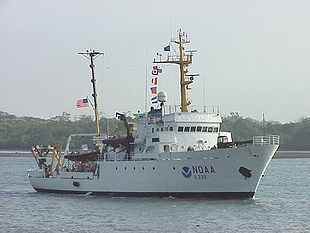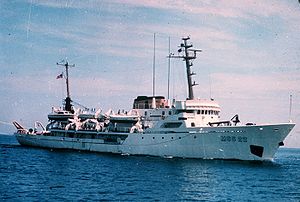NOAAS McArthur (S 330)
 NOAAS McArthur (S 330) sometime between 1970 and 2003 | |
| Career (United States) | |
|---|---|
| Name: | McArthur |
| Namesake: | William Pope McArthur (1814-1850), a United States Coast Survey officer who pioneered hydrographic survey work on the United States West Coast |
| Builder: | Norfolk Shipbuilding and Drydock Company, Norfolk, Virginia |
| Laid down: | 15 July 1965 |
| Launched: | 15 November 1965 |
| Commissioned: | 15 December 1966 |
| Decommissioned: | 20 May 2003 |
| Homeport: | Seattle, Washington |
| Nickname: | "Mini-Mac" (after commissioning of the larger NOAAS McArthur II (R 330), known as "Big Mac," in May 2003)[1] |
| Fate: | Sold to Blackwater Worldwide 2006 |
| Notes: |
Served in U.S. Coast and Geodetic Survey 1966-1970 Served in National Oceanic and Atmospheric Administration 1970-2003 Has served as Blackwater Worldwide training ship McArthur since 2007 |
| General characteristics | |
| Type: | McArthur-class hydrographic survey ship |
| Tonnage: | 854 gross register tons; 207 net register tons |
| Displacement: | 995 tons (full load) |
| Length: | 175 ft (53 m) |
| Beam: | 38 ft (12 m) |
| Draft: | 12.1 ft (3.7 m) |
| Installed power: | 1,600 horsepower (2.1 megawatts) |
| Propulsion: | Two General Motors diesel engines, twin controllable-pitch propellers, 186 tons fuel |
| Speed: | 12 knots |
| Range: | 6,000 nautical miles at 12 knots |
| Endurance: | 17 days |
| Complement: | Either 23 (6 officers and 17 crew) plus up to 13 scientists[2] or 38 (8 NOAA Corps officers, 3 licensed engineers, and 27 other crew, plus up to 2 scientists[3] |
| Notes: | 440 kilowatts electrical power; Hydroplot PDP 11/34 computer |
NOAAS McArthur (S 330), originally the second USC&GS McArthur (MSS 22), was a survey ship in service with the United States Coast and Geodetic Survey from 1966 to 1970 and with the National Oceanic and Atmospheric Administration (NOAA) from 1970 to 2003.
Construction and commissioning

McArthur was laid down on 15 July 1965 by the Norfolk Shipbuilding and Drydock Company at Norfolk, Virginia, and launched on 15 November 1965. She entered service with the Coast and Geodetic Survey on 15 December 1966 as USC&GS McArthur (MSS 22). When the Coast and Geodetic Survey merged with other agencies to form NOAA on 3 October 1970, McArthur became part of the NOAA fleet as NOAAS McArthur (S 330).
McArthur has one sister ship, the former NOAAS Davidson (S 331).
Career
With her home port at Seattle, Washington, McArthur spent her career operating along the United States West Coast, in Alaskan waters, and in the eastern Pacific Ocean. She began her career operating as a hydrographic survey ship, but later became primary U.S. West Coast current survey vessel. She engaged in measurements of chemical, meteorological, and biological sampling for several large-scale programs within NOAA. Her work was focused primarily on the exclusive economic zone of the United States off the U.S. West Coast, especially in several of the National Marine Sanctuaries there. She also conducted Chase Encirclement Stress Studies (CHESS) -- marine mammal surveys throughout the eastern tropical Pacific -- and took part in the Oregon, California, Washington (ORCAWALE) Project in support of protected species research efforts; she also participated in the Sustainable Seas Expedition. The scientists who carried out research aboard McArthur came from many divisions of NOAA, as well as other United States Government agencies, U.S. state government agencies, and academia.
Decommissioning
McArthur was decommissioned on 20 May 2003 at the NOAA Marine Operations Center at Seattle and replaced in the NOAA fleet by the oceanographic research ship NOAAS McArthur II (R 330), which was commissioned the same day in a combined ceremony.
Sale
McArthur was sold to Blackwater Worldwide in 2006, for use by that company as a training ship and private maritime security ship under the name McArthur. She entered service with Blackwater Worldwide in 2007.
Notes
- ↑ NOAA Ship McArthur II / R-330 Welcome aboard Packet - noaa.gov - Retrieved December 27, 2007
- ↑ Per NOAA Marine Operations (at http://www.moc.noaa.gov/ar1/index.html).
- ↑ Per Combat Fleets of the World 1984/85, p. 987.
References
- NOAA Marine Operations NOAA Ship McArthur
- NOAA History, A Science Odyssey: Tools of the Trade: Ships: Coast and Geodetic Survey Ships: McArthur
- Miramar Ship Index: Single Ship Report for "6602082"
- Couhat, John Labayle, and A. D. Baker III, eds. Combat Fleets of the World 1984/1985: Their Ships, Aircraft, and Armament. Annapolis, Maryland: United States Naval Institute, 1984. ISBN 0-87021-136-6.
- Prézelin, Bernard, and A. D. Baker III, eds. The Naval Institute Guide to Combat Fleets of the World 1990/1991: Their Ships, Aircraft, and Armament. Annapolis, Maryland: United States Naval Institute Press, 1990. ISBN 0-87021-250-8.
| ||||||||
